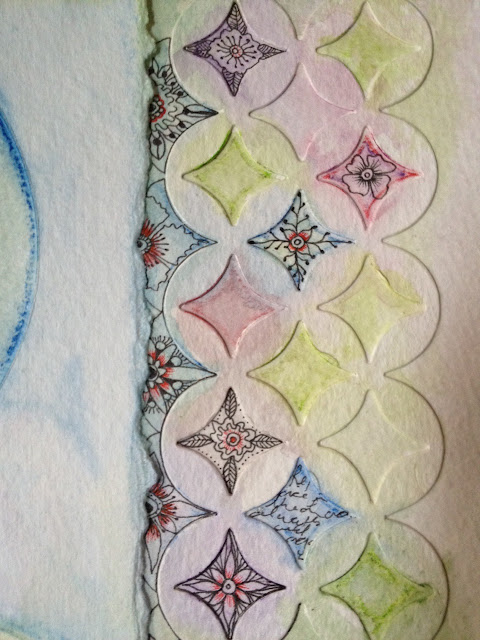Looking back at the last tutorial I thought that I should mention that Inktense pencils are usually thought of as producing vivid spectacular colours of Indian Ink, and they really do! One of the things that I love so much about them is the way we can immerse ourselves in the joy of using pure, bright colours in our artwork.
But there are lots of fab tutorials on how to get them to release their full colour and it takes a little more practice and thought to use them for subtle blending techniques. It is also good to know that if we have them in our art kit, that they can be used in many ways. This is a slower and more relaxing way of painting which is great for calming the mind.
So lets look at adding some shading and detail to our artwork.
At this stage I usually start to think about what images or doodles I'd like in my circles. I usually don't fill every space because I sometimes like there to be a calmness of some empty spaces.
In Art, there is as much importance in what we leave out as to what we put into our pieces and negative space, the space between, is a great decorative tool.
As you look at your work so far see if any shapes leap out at you. The green oval shape looked like a leaf to me so I added some veins with a black Pigma Micron pen.
The lines in the paint next to the leaf looked faintly like the petals of a flower so I followed the lines with the pen and made a flower.
There was space for another leaf so I copied the shape of the other leaf, and then there were two!
Once the shape of the flower is made you can outline it with the pencils and blend the colour inwards. I added a yellow centre to the flower and blended it gently outwards.
This gives a very subtle natural 'bloom' to the flower. I also added some shade below the flower and leaf to make them look more 3D.
To do this just use a grey or blue and draw a line along the outside of the shape and use a tiny bit of water to blend it into the background. It also disguised the bit where my pencil slipped and gave me a wonky line. I will doodle over it later.
Now lets have a look at adding some detail to the trellis. Last time I drew around the inside of the shaped with the pencils and wet it to soften the colours. Today I started drawing in the spaces.
This photo is very much enlarged to show you the doodles. Anything goes really. The spaces are tiny and you just want to give them some interest. I used the Sakura Pigma Micron pen again for this because it is waterproof when dry and I can go over it with more colour later. I used a 0.1 nib size.
My biggest circle next!
I have chosen to draw a bird in my largest circle and I think this will become my focal point so I will add the most detail to this. If you don't feel confident to draw freehand, you can stamp an image instead. Remember to use a permanent ink like Stazon so you can add water and pencil over it.
Can you see the difference that shading brings to the image? I outlined the bird and the scallop edging with grey and blended them towards the centre of the circle and it make the image come alive! I added a little more yellow to the bird too.
I also drew tiny spirals around one side of the bird to make it look like it was emerging out of the clouds. Little red details make the image pop and keep it from looking too dark.
I've decided that I don't like that pesky porthole circle below the bird. So I'm going to change it!I've given it a wash of green and yellow. Then whilst it is wet I have drawn a yellow circle in yello and outlined it in Sepia Brown.I have also drawn the petals around it in Sepia.
Then I addad some mor between the petals and blended it.
To finish my daisy I doodled around the edges of the circle and in the centre of the flower.
So that's it! I think I'm done. I have finished by shading around everything to give it a bit of depth.
Next time I will show you some simple techniques for Inktense pencils on fabric. Keep watching.












Very beautiful...thank you for the share.
ReplyDeleteVery beautiful. Thank you for sharing.
ReplyDelete